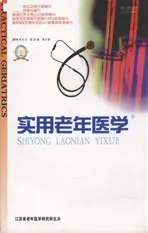血清25-羟维生素D与老年良性前列腺增生的相关性研究
2016-08-25巩云霞庞小芬
巩云霞 庞小芬
血清25-羟维生素D与老年良性前列腺增生的相关性研究
巩云霞庞小芬
目的探讨血清25-羟维生素D(25-OH-D)与老年良性前列腺增生的相关性。方法研究对象为2014年1~12月上海瑞金医院老年病科住院的前列腺增生病人113例。测量空腹血糖、糖化血红蛋白、肾功能、血钙磷、血脂、前列腺特异性抗原及25-OH-D,根据25-OH-D水平分为25-OH-D <50 nmol/L组(维生素D缺乏组)和25-OH-D≥50 nmol/L组(正常组)。超声检查计算前列腺体积(PV),采用国际前列腺症状评分法(I-PSS)评估下尿路梗阻症状,并对2组患者的相关数据进行对比分析。 结果血清25-OH-D≥50 nmol/L者32例(28.3%),血清25-OH-D<50 nmol/L者81例(71.7%)。维生素D缺乏组PV明显大于正常组(P<0.05),I-PSS评分明显高于正常组(P<0.01)。多元线性回归显示25-OH-D与I-PSS相关(P<0.01)。 结论老年男性良性前列腺增生程度与血清25-OH-D水平呈负相关。维生素D及其类似物或许可成为治疗前列腺增生导致下尿路梗阻的新靶点。
维生素D; 前列腺增生; 老年人
前列腺增生是老年男性最常见疾病之一,其导致的下尿路梗阻症状严重影响老年男性日常生活,降低其生活质量。目前的药物治疗主要包括抑制前列腺增生的抗雄激素药物及改善症状的α受体阻断剂。维生素D除了具有调节钙磷代谢的经典作用外[1],与其他疾病如代谢综合征、心脑血管病、某些恶性肿瘤及自身免疫性疾病均有相关性[2-6]。亦有文献报道,维生素D缺乏与前列腺增生的发生发展相关[7-8],前列腺增生患者使用维生素D及其衍生物、维生素D受体激动剂可抑制前列腺增生的进展,改善下尿路梗阻症状[9]。老年男性中血清维生素D缺乏者众多,故本文对血清25-羟维生素D(25-OH-D)水平与老年前列腺增生的相关性进行了初步探讨。
1 资料和方法
1.1研究对象研究对象来自2014年1~12月上海交通大学医学院附属瑞金医院老年病科住院病人,共113例,年龄65~94岁,平均(79.4±9.2)岁,排除各种恶性肿瘤、严重肝肾功能不全、原发性甲状腺及甲状旁腺功能异常患者以及服用各种维生素D制剂者。
1.2研究方法
1.2.1体格检查及生化检查:对新入院病人询问病史、体格检查,记录身高、体质量,计算体质量指数(BMI),并测量血压。晚8时禁食后次晨空腹抽取静脉血,分别送检空腹血糖(FBG)、糖化血红蛋白(HbA1c)、尿素氮(BUN)、肌酐(CR)、尿酸(UA)、血钙(Ca)、血磷(P)、三酰甘油(TG)、总胆固醇(TC)、低密度脂蛋白胆固醇(LDL-C)、高密度脂蛋白胆固醇(HDL-C)、前列腺特异性抗原(PSA)、游离前列腺特异抗原(fPSA)及25-OH-D。采用德国罗氏公司的Cobase 601自动化免疫分析仪通过电化学发光法检测25-OH-D,严格按试剂盒说明书由专人操作。根据美国内分泌学会最新发布的维生素D临床实践指南将人群分为血清25-OH-D≥50 nmol/L组及血清25-OH-D<50 nmol/L组进行分析。
1.2.2前列腺体积(PV)计算:由本院超声诊断科专人检查,使用Philips IU 22彩色超声诊断仪,探头经腹部分别测量前列腺纵径(A)、横径(B)及前后径(C),计算PV(ml)。PV=A×B×C×0.52。
1.2.3国际前列腺症状评分法(I-PSS)评定患者下尿路梗阻症状:患者回答I-PSS表中7个问题,每个问题答案为0~5分,7个问题所得的分值相加即为患者的总分值,分值越高提示下尿路梗阻症状越重。

2 结果
2.1血清25-OH-D水平分布情况113例患者平均血清25-OH-D浓度为(42.0±20.1) nmol/L,血清25-OH-D≥50 nmol/L 32例,占28.3%,平均血清浓度为(66.7±13.8) nmol/L;血清25-OH-D<50 nmol/L 81例,占71.7%,平均血清浓度为(32.13±12.1) nmol/L。
2.22组一般资料比较2组患者合并高血压分别为22例(69.4%)、55例(67.9%),合并2型糖尿病分别为12例(37.5%)、30例(37.0%),合并冠心病分别为4例(12.5%)、11例(13.4%),差异均无统计学意义(P>0.05)。2组间年龄、身高、血压、血TG、LDL-C、HDL-C、BUN、CR、UA、FBG、HbA1c、Ca、P水平差异亦无统计学意义(P>0.05)。血清25-OH-D≥50 nmol/L组体质量、BMI低于25-OH-D<50 nmol/L组(P<0.05),TC高于25-OH-D<50 nmol/L组,差异有统计学意义(P<0.05),见表1。

表1 2组不同水平血清25-OH-D患者的一般资料比较
2.32组间PV及I-PSS评分比较血清25-OH-D≥50 nmol/L与25-OH-D<50 nmol/L 组间PSA及fPSA差异无统计学意义(P>0.05);25-OH-D<50 nmol/L组PV明显大于血清25-OH-D≥50 nmol/L组(P<0.05),25-OH-D水平<50 nmol/L组I-PSS评分明显高于25-OH-D<50 nmol/L组(P<0.01)。见表2。

表2 血清25-OH-D与PV及I-PSS评分的组间比较
2.4多元逐步线性回归法分析前列腺增生的危险因素将PV作为因变量,年龄、血压、BMI、FBG、HbA1c、BUN、CR、UA、Ca、TG、TC、LDL-C、HDL-C、血清25-OH-D作为自变量进行多元逐步线性回归,最终年龄、HbA1c、BMI进入方程,但仅年龄(x1)、HbA1c(x2)有统计学意义,回归方程为y=-88.3+8.2x1+0.6x2。将I-PSS作为因变量,年龄、血压、BMI、FBG、HbA1c、BUN、CR、UA、Ca、TG、TC、LDL-C、HDL-C、血清25-OH-D作为自变量进行多元逐步线性回归,最终年龄(x1)、HbA1c(x2)、血清25-OH-D(x3)进入方程(P<0.05),回归方程为y=5.1+0.1x1+0.9x2-0.1x3。见表4。

表4 PV及I-PSS与各变量的多元回归分析
3 讨论
维生素D在体内分别经肝脏、肾脏2次羟化转变成1,25(OH)2D3,其除了大家熟知的调节钙磷代谢功能以外[1],还具有调节细胞生长和分化、调节免疫及抗炎作用[2,5]。1,25(OH)2D3需与体内维生素D受体结合发挥作用。维生素D受体在体内分布广泛,不仅存在于小肠、肾脏、骨骼、甲状旁腺等经典靶器官,还分布于泌尿生殖道组织中,如前列腺、膀胱,前列腺尿道部维生素D受体甚至多于前列腺与膀胱颈部[10]。
前列腺增生的发病机制很多,有生长因子学说、激素-内分泌学说、上皮-细胞学说、细胞凋亡与基因调控学说等,近些年来多数学者认为炎症在前列腺增生的发生、发展过程中起重要作用[11-12]。维生素D对前列腺的可能保护机制有:(1) 1,25(OH)2D3可下调多种炎性因子的表达,如白介素(IL)-1、IL-2、IL-8、肿瘤坏死因子(TNF)-α、前列腺素、环氧化酶等[11]。这些炎性因子在前列腺增生的发生发展过程中起重要作用。(2)通过p27、p21以及Myc等基因表达产物,调节细胞周期蛋白依赖性激酶(CDK),调控细胞周期,抑制细胞生长[10,13]。(3)1,25(OH)2D3与前列腺局部维生素D受体结合后通过调节多种多肽生长因子如胰岛素样生长因子(IGF)-Ⅰ、IGF-Ⅱ等,诱导前列腺基质细胞和上皮细胞的凋亡[14]。Bao等[9]研究发现活性维生素D能保护良性前列腺增生细胞免除氧化应激所导致的细胞凋亡,防止前列腺增生导致的下尿路梗阻症状;日本学者亦发现维生素D激动剂有相同的生物学效应[15]。本研究中血清25-OH-D<50 nmol/L组PV、I-PSS评分明显大于血清25-OH-D≥50 nmol/L组(P<0.05),老年男性体内血清中维生素D水平与前列腺增生呈负相关,这与国内外学者的研究结论一致。瑞典学者Haghsheno等[7]研究显示前列腺增生患者血清25-OH-D浓度为60.52 nmol/L,而PV正常者为68.17 nmol/L(P=0.006),提示血清低25-OH-D水平与良性前列腺增生有关。郏蓉等[8]也探讨了血清25-OH-D与良性前列腺增生的相关性,结果显示低水平维生素D组PV高于高水平维生素D组,PV与血清25-OH-D呈负相关关系。低血清25-OH-D或许是良性前列腺增生的危险因素之一。
本研究仅是一个横断面研究,且样本较少,涉及前列腺增生发生发展机制中的某些细胞因子、相关基因表达产物未进行检测,也未观察维生素D及其类似物、维生素D受体激动剂对前列腺增生患者的干预结果,尚需更大样本、前瞻性队列研究证实。
本研究提示老年前列腺增生与血清维生素D水平呈负相关。维生素D及其类似物、维生素D受体激动剂或许可成为治疗前列腺增生导致下尿路梗阻的新靶点,但需更大样本的前瞻性研究证实。
[1]Kogawa M, Findlay DM, Anderson PH, et al. Osteoclastic metabolism of 25(OH)-vitamin D3:a potential mechanism for optimization of bone resorption [J].Endocrinol, 2010,151(10):4316-4625.
[2]Holik MF.Vitamin D deficiency [J].N Engl J Med, 2007,357(3):266-281.
[3]Wang TJ, Pencina MJ, Booth SL, et al.Vitamin D deficiency and risk of cardiovascular disease [J].Circulation,2008,117(4):503-511.
[4]So JY, Lee HJ, Smolarek AK, et al. A novel Gemini vitamin D analog represses the expression of a stem cell marker CD44 in breast cancer[J].Mol Pharmacol, 2011, 79(3):360-367.
[5]Asgari MM, Tang J, Warton ME, et al. Association of prediagnostic serum vitamin D levels with the development of basal cell carcinoma[J].J Invest Dermatol, 2010,130(5):1438-1443.
[6]Kayaniyil S, Vieth R, Harris SB, et al. Association of 25(OH)D and PTH with metabolic syndrome and its traditional and nontraditional components[J].J Clin Endocrinol Metab, 2011,96(1):168-175.
[7]Haghsheno MA, Mellström D, Behre CJ, et al. Low 25-OH vitamin D is associated with benign prostatic hyperplasia[J].J Urol, 2013,190(2):608-614.
[8]郏蓉,苗懿德,陈陵霞,等.老年男性前列腺增生与血清25-羟维生素D水平的相关性研究[J].中华老年医学杂志,2014,33(1):59-61.
[9]Bao BY, Ting HJ, Hsu JW, et al. Protactive role of 1α,25-dihydroxyvitamin D3agaist oxidative stress in nonmalignant human prostate epithelial cells[J]. Int J Cacer, 2008, 122(12):2699-2706.
[10]Crescioli C, Morelli A, Adorini L, et al. Human bladder as a novel target for vitamin D receptor ligands[J].J Clin Endocrinol Metab,2005,90(2):962-972.
[11]Nickel JC, Roehrborn CG, O’leary MP, et al. Examination of the relationship between symptoms of prostatitis and histological inflammation:baseline data from the REDUCE chemoprevention trial[J].J Urol,2007,178(3):896-900.
[12]Gandaglia G, Briganti A, Gontero P, et al. The role of chronic prostatic inflammation in the pathogenesis and progression of benign prostatic hyperplasia (BPH)[J]. BJU Int,2013,112(4):432-441.
[13]Tiwari A. Elocalcitol, a vitamin D3analog for the potential treatment of benign prostatic hyperplasia,overactive bladder and male infertility[J]. Drugs, 2009, 12(6):381-393.
[14]Huynh H, Pollak M, Zhang JC. Regulation of insulin-like growth factor (IGF) II and IGF binding protein 3 autocrine loop in human PC-3 prostate cancer cells by vitamin D metabolite 1,25(OH)2D3and its analog EB1089[J]. Int J Oncol, 1998, 13(1):137-143.
[15]Taniguchi K, katagiri K, Kashiwagi H, et al. A novel nonsecosteroidal VDR agonist(CH5036249) exhibits efficacy in a spontaneous benign prostatic hyperplasia beagle model[J].J Steroid Biochem Mol Biol,2010,121(1):204-207.
Study on the relationship between serum 25-hydroxy vitamin D and benign prostatic hyperplasia in elderly men
GONGYun-xia,PANGXiao-fen.
DepartmentofGeriatrics,RuijinHospital,ShanghaiJiaotongUniversitySchoolofMedicine,Shanghai200025,China
ObjectiveTo explore the relationship between serum level of 25-hydroxy vitamin D(25-OH-D) and benign prostatic hyperplasia in elderly men.MethodsOne hundred and thirteen old men hospitalized in Department of Geriatrics in Shanghai Ruijin Hospital from January to December 2014 were enrolled. Blood pressure, body mass index(BMI), fasting plasma glucose, glycosylated hemoglobin, renal function, serum calcium(Ca), serum phosphorus(P), blood lipid, prostate specific antigen (PSA) and serum 25-OH-D were measured in all patients. Prostate volume was examined by type-B ultrasound, and the symptoms of urinary tract obstruction were evaluated by I-PSS.ResultsThere were 32(28.3%) cases with 25-OH-D≥50 nmol/L, and 81(71.7%)cases with 25-OH-D<50 nmol/L, respectively. The prostate volume, I-PSS in the group with 25-OH-D <50 nmol/L were higher than those in the group with 25-OH-D≥50 nmol/L(P<0.05 orP<0.01). Correlation analysis showed that I-PSS was negatively correlated with 25-OH-D(P<0.01).ConclusionsThe degree of benign prostatic hyperplasia of elderly men is negatively correlated with serum vitamin D. Vitamin D and its analogs may be the new targets for the treatment of urinary tract obstruction caused by prostate hyperplasia.
vitamin D; prostatic hyperplasia; aged
200025上海市,上海交通大学医学院附属瑞金医院老年病科
R 697.32
Adoi:10.3969/j.issn.1003-9198.2016.06.007
2015-06-24)
